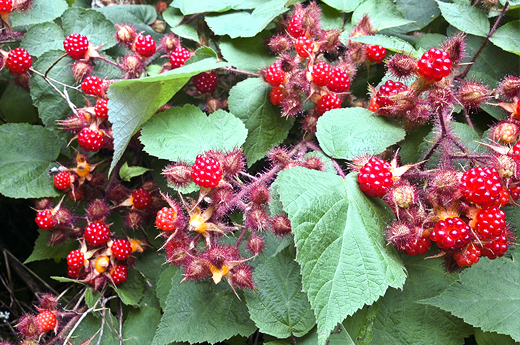
For all of you lazy buns out there who don’t want to start a garden but still want to help heal nature (and humanity, by the way), I have an idea for you. Take a piece of your yard—any piece—and make it a designated wilderness zone. Cultivate some wildness! It seems a little scandalous, doesn’t it? To either let a part of your yard go completely or embrace the wildness that’s already there (and not feel guilty about it)… It’s the ultimate personal and political statement.
Do you remember in the ’60s when grownups didn’t like kids having long hair? Some parents even disowned their sons because of their hair—or, as Bruce Springsteen tells it, brought in a barber to shave their head while incapacitated and in bed from a motorcycle accident that was not their fault.
Well, now anybody can have long hair, or a beard, and it’s no big deal. But the way moms and dads felt about long hair back then in the ’60s is how a lot of farmers feel about wildness and weeds today. It threatens their masculinity and their sense of belonging to see wildness on their land or lawns.
When everything is neat and tidy, you get a sense of control. And that would be mythical control, because one week of not thinking about it and Mother Nature is back in control again, popping out little weeds and thinking of new ways to provoke your sense of order.
What’s ironic is that Nature is fundamentally ordered and organized; if you just let things go, she’ll takes care of it for you. However, she needs her SPACE. So I need you to give her some. Just a little! As I said in my blog last week, a patch of weeds is like a truck stop on Nature’s highway. Consider it an investment in more free time!
This idea isn’t new. When I studied Permaculture with Bill Mollison, he talked about breaking your yard up into zones. Zone 0 is the house. Zone 1 is areas close to the home that need continual monitoring and site visits—think spaces where you go every day (weather permitting), where perhaps you have an herb or salad garden and some chickens. Zone 2 is a bit more on the outskirts—maybe your kids’ play area or the woodshed, or even beehives. Zone 3 is even farther out—a place where you may have an orchard or pasture. Zone 4 is perhaps a managed wild area for wood, foraging, and hanging out. Zone 5 is total wildness, unmanaged nature.
Even if you live in the suburbs or the city, you can think of your space in this way.
Why is wildness so essential? Well, that’s where Nature is free to do her business, which means creating, cultivating, and feeding life—the life we need to survive! It’s a home for all sorts of critters. It’s a veritable smorgasbord for everyone. Even underground, the fungi, bacteria, and insect life are working hard to create a healthy universe. When left undisturbed (by not tilling or digging), those creatures can really get things done! And when Nature gets things done, we all end up healthier and happier.
Recently, while in California, I came across an organization called the Wild Farm Alliance, which is helping farmers embrace their wild side. It’s funny, because a lot of farmers I know enjoy going into the woods and hunting. So I know they love wildness in their deepest souls. But somehow, when that gets translated to farm fields—or lawns for that matter—the need to control takes over and out come the chemicals to “make their lives easier.”
Here’s what’s super easy: letting go, surrendering a little bit of space to nature and embracing the wildness that brings diversity and life to everyone and everything. So while you are “cultivating” wildness, you can do all sorts of other things. Like take a nap. Read a book. Go for a walk. Have sex (that’s what is going on in that wild patch, after all!).
Or just simply watch the miracle of Nature doing her magic.




By the way, the photo is of berries that grow wild on the edge of my driveway. I couldn’t plant them even if I wanted to — only nature can plant berries like that! SWEET!
I was just going to say how beautiful and mouthwatering those berries look, and disease free to boot! They remind me of the small, wild French strawberries, and it makes me want to just pick them off and eat every one of them over a humongous scoop of Ben and Jerry’s Vanilla Bean Ice Cream! Yum. Nice post Maria! This is something I could do with a piece of my property. I’m tired of fighting weeds and other things that grow prolifically in that area. This would definitely free up some much need time in the summer months! Why didn’t I think of that?!!!
I’m wondering if this would work with the 12 pots located on my balcony, on the 4th floor of the senior citizen apartment bldg. where I now live?? Maybe I could plant flowers in some and let some just go wild and see what happens. The worst that could happen is that I’d just have half as many flowers, but the best thing could be to see what might grow in the other pots! I think I’ll try it! Thanks, Maria, you are full of good ideas.